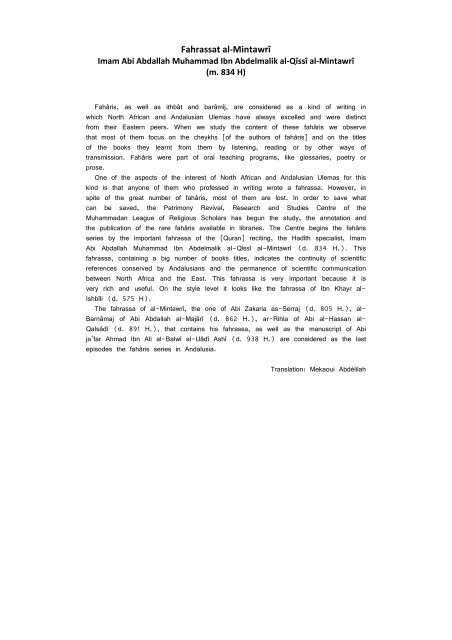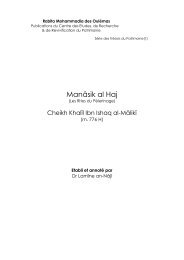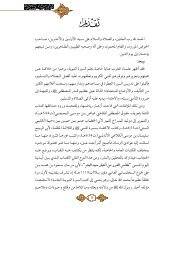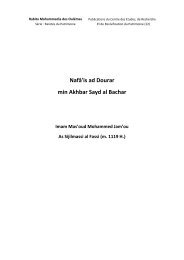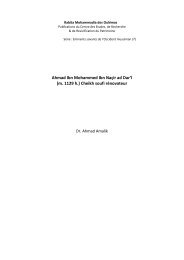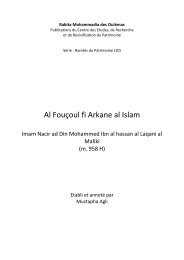Fahrassat al-Mintawrî
Fahrassat al-Mintawrî
Fahrassat al-Mintawrî
Create successful ePaper yourself
Turn your PDF publications into a flip-book with our unique Google optimized e-Paper software.
<strong>Fahrassat</strong> <strong>al</strong>-<strong>Mintawrî</strong><br />
Imam Abi Abd<strong>al</strong>lah Muhammad Ibn Abdelm<strong>al</strong>ik <strong>al</strong>-Qîssî <strong>al</strong>-<strong>Mintawrî</strong><br />
(m. 834 H)<br />
Fahâris, as well as ithbât and barâmîj, are considered as a kind of writing in<br />
which North African and And<strong>al</strong>usian Ulemas have <strong>al</strong>ways excelled and were distinct<br />
from their Eastern peers. When we study the content of these fahâris we observe<br />
that most of them focus on the cheykhs [of the authors of fahâris] and on the titles<br />
of the books they learnt from them by listening, reading or by other ways of<br />
transmission. Fahâris were part of or<strong>al</strong> teaching programs, like glossaries, poetry or<br />
prose.<br />
One of the aspects of the interest of North African and And<strong>al</strong>usian Ulemas for this<br />
kind is that anyone of them who professed in writing wrote a fahrassa. However, in<br />
spite of the great number of fahâris, most of them are lost. In order to save what<br />
can be saved, the Patrimony Reviv<strong>al</strong>, Research and Studies Centre of the<br />
Muhammadan League of Religious Scholars has begun the study, the annotation and<br />
the publication of the rare fahâris available in libraries. The Centre begins the fahâris<br />
series by the important fahrassa of the [Quran] reciting, the Hadîth speci<strong>al</strong>ist, Imam<br />
Abi Abd<strong>al</strong>lah Muhammad Ibn Abdelm<strong>al</strong>ik <strong>al</strong>-Qîssî <strong>al</strong>-<strong>Mintawrî</strong> (d. 834 H.). This<br />
fahrassa, containing a big number of books titles, indicates the continuity of scientific<br />
references conserved by And<strong>al</strong>usians and the permanence of scientific communication<br />
between North Africa and the East. This fahrassa is very important because it is<br />
very rich and useful. On the style level it looks like the fahrassa of Ibn Khayr <strong>al</strong>-<br />
Ishbîli (d. 575 H).<br />
The fahrassa of <strong>al</strong>-<strong>Mintawrî</strong>, the one of Abi Zakaria as-Serraj (d. 805 H.), <strong>al</strong>-<br />
Barnâmaj of Abi Abd<strong>al</strong>lah <strong>al</strong>-Majârî (d. 862 H.), ar-Rihla of Abi <strong>al</strong>-Hassan <strong>al</strong>-<br />
Q<strong>al</strong>sâdî (d. 891 H.), that contains his fahrassa, as well as the manuscript of Abi<br />
ja’far Ahmad Ibn Ali <strong>al</strong>-B<strong>al</strong>wî <strong>al</strong>-Uâdî Ashî (d. 938 H.) are considered as the last<br />
episodes the fahâris series in And<strong>al</strong>usia.<br />
Translation: Mekaoui Abdélilah


